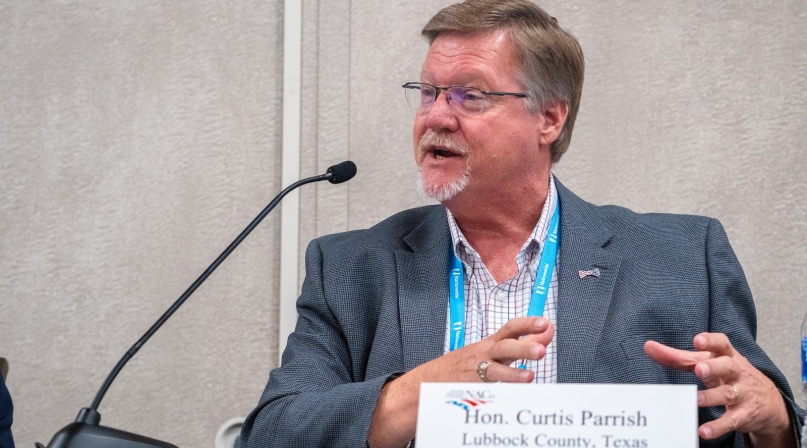Arena construction is a full-contact sport for counties

Key Takeaways
Professional sports team owners want to go deep when building stadiums and arenas, getting open while counties foot the bill. As stewards of the public coffers, counties have to bump and jam them off the line of scrimmage, telling them in no uncertain terms, “not so fast.”
“Billionaires make a lot of money using other people’s money, and if you give in to them, they will make you spend everything,” said Erie County, N.Y. Executive Mark Poloncarz, who literally wrote the book, “Behind the Xs and Os,” about negotiating with an NFL franchise.
Built right, arenas for sports and other events can be around for a long time. The Lubbock Municipal Coliseum in Texas was around for more than 60 years. Erie County is finally nearing a chance to unload the Buffalo Bills’ stadium, now called Highmark Stadium, which the county has owned since 1973, when it was built for $23 million.
“I would love to be able to build a football stadium for $23 million,” Poloncarz said.
Shortly into his tenure, Poloncarz negotiated the agreement that saw the Bills contribute to the stadium’s upkeep for the first time in 40 years. Now, with the venerated building due to be torn down in a few years, Poloncarz sees the opportunity for the county to get out of the football stadium business once the replacement is complete.
“…Because of all the liability issues that exist in regard to owning a major professional sports team,” he said, “people are not always in the best state of mind when they go to football games. I don’t get what the 22-year-olds think about jumping on a table that’s on fire that’s related to professional football, but they do that, and then they walk into your stadium and they stumble and they smash their head on the concrete when they fall down and of course it’s the owner who gets sued.”
Poloncarz said the process of negotiating with a professional sports team usually plays out against the threat of relocation.
“If you are negotiating a lease with a major professional sports team, you need to hire outside counsel who understands that league, because they have all kinds of financing mechanisms,” he said.
Erie County will contribute $250 million to the $1.4 billion cost of building a new stadium, and that’s it, he said. The Bills will be responsible for cost overruns. Lubbock County has also nailed down its $35 million contribution to the expo center that is already moving north of $120 million total.
“Make sure that whoever you’re partnering with, whoever that is, knows that your fixed amount is this and no more, that these cost overages that will inevitably be coming to your project must be incurred by something other than the taxpayers of your county,” Parrish said. “That is our job as county officials — to protect our citizens if we were to incur the overages that that are being anticipated.”
Even though Erie County won’t own the new stadium, it will own the parking lot, which makes the county a party to the community benefits agreement, that will amount to millions of dollars that a third party will manage, which can be used to benefit the surrounding community.
While Poloncarz preferred the new stadium be built in downtown Buffalo, having control of the old stadium site and parking lot will help the county retain that leverage.
Assurances about the fate of surrounding neighborhoods is what kept Knox County, Tenn. Commissioner Dasha Lundy from opposing the Knoxville Multi-Use Stadium in her district.
“I was a ‘no’ two weeks before our vote,” she said. “I lost sleep for months. How can I vote yes, when in the background, this is where urban renewal happened? this is where a Black business district was removed in the 1960s, where people lost their homes and churches?”
On top of that, she was worried about how new development would upend property values near the stadium.
“I definitely believe in economic development, but my question is, I always ask, ‘How do you develop without displacing?’” she said. “So, what can we do to make sure this multi-use stadium serves everybody and not just a certain population?”
The Tennessee Smokies owner, who also serves as president of the University of Tennessee, assured Lundy by giving a proportionate share of the sports authority vote to members of minority groups who live near the stadium, an internship program for local youths and a commitment to local hiring during construction of the stadium, which will cost more than $150 million.
“It’s an amazing opportunity for my community,” she said. “I kept thinking about all those subcontractors, those minority-owned businesses who just want a chance to maybe make five or six figures in their life.”
Attachments
Related News
Eastern Tennessee counties collaborate on nuclear energy ambitions
Decades after the Manhattan Project, cooperation among Roane, Anderson and Knox counties in Tennessee drives toward a high profile for nuclear power.

County repurposes airport’s lost and found items for animal shelter
Broward County, Fla. staff made use out of items left behind at the county airport.

EPA releases proposal to repeal 2009 greenhouse gas endangerment finding
On July 29, the Environmental Protection Agency (EPA) released a proposal to rescind the 2009 endangerment finding. Following the announcement from EPA Administrator Lee Zeldin, the U.S. Department of Energy (DOE) published a supporting report—A Critical Review of Impacts of Greenhouse Gas Emissions on the U.S. Climate.
